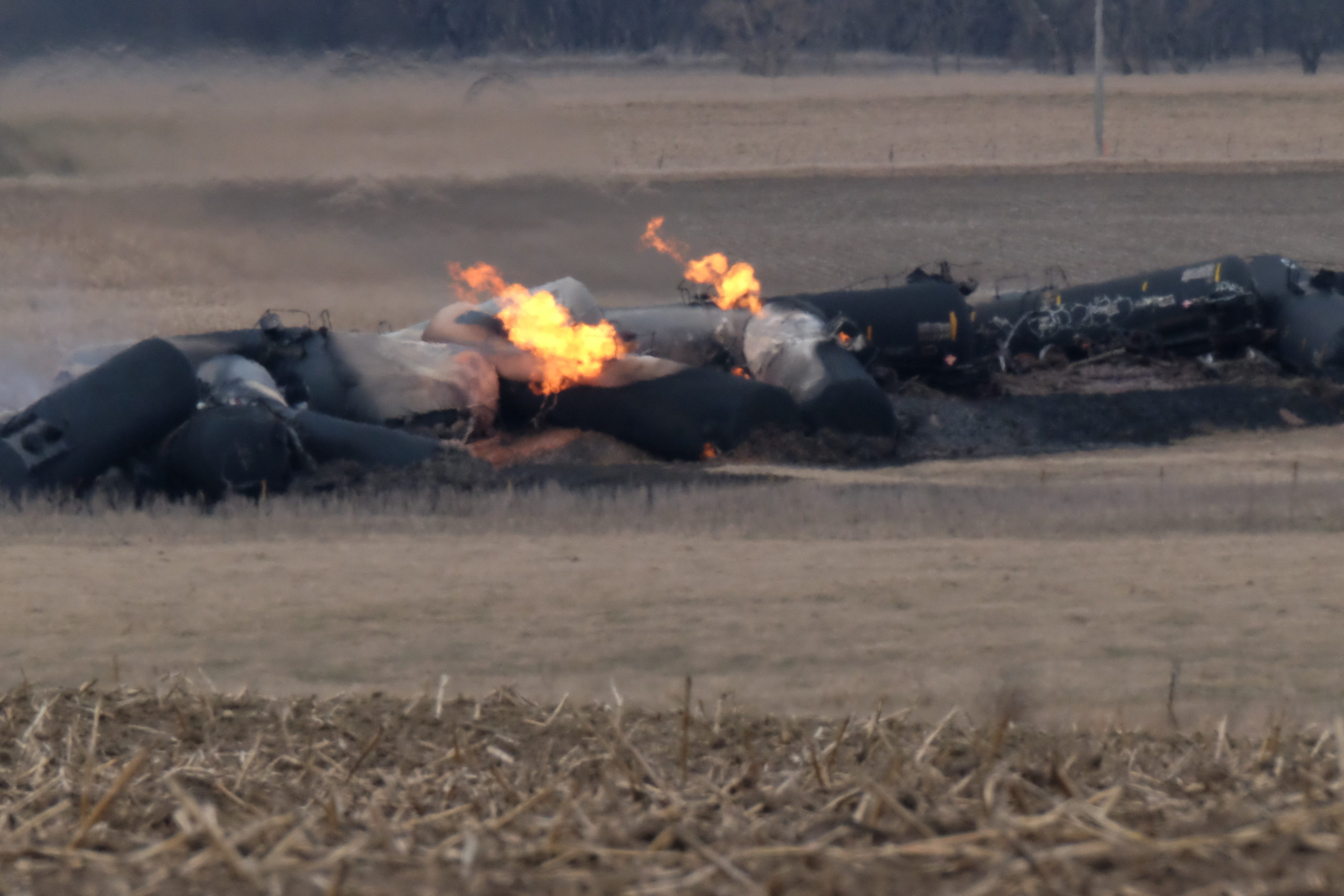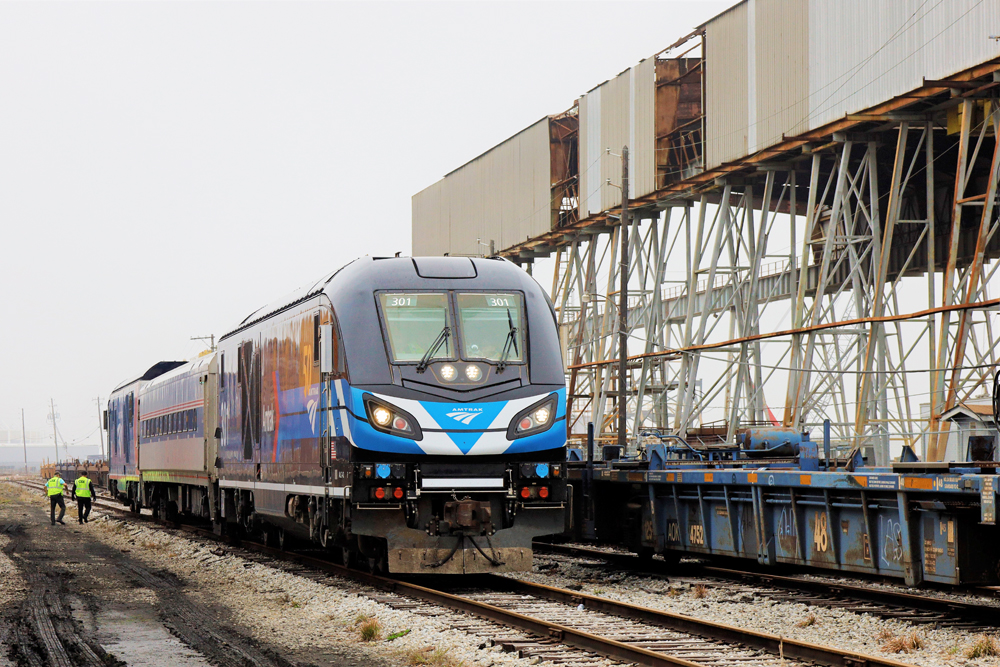NTSB officials met Tuesday to discuss its findings regarding the 20-car derailment of a Union Pacific train near Graettinger, Iowa, on March 10, 2017. In that derailment, 14 cars released nearly 322,000 gallons of denatured ethanol, causing a fire.
Of top concern to the NTSB and its staff are the maintenance and safety conditions of UP tracks, what the Federal Railroad Administration is doing to make sure tracks are in good condition, and the status of the flammable liquid fleet that is required to meet new Department of Transportation safety standards by May 2023.
In his opening remarks, NTSB Chairman Robert Sumwalt said that railroads are supposed to look for and fix unsafe conditions while federal oversight ensures the railroads do what they’re supposed to do.
“After the accident, Union Pacific undertook an impressive program of corrective actions,” Sumwalt said. But the flurry of activity “hints at the inadequacy of UP’s maintenance and inspection program pre-accident.”
Investigators showed a 3D digital recreation of the derailment, informed by data recovered from locomotive event recorders and external video. The video illustrated the moments leading up to and then the immediate aftermath of the derailment. According to Dr. Erik Mueller, a materials research engineer for the NTSB, the train likely derailed from a broken rail leading over the Jack Creek bridge. The investigators believe the rail, on the south side of the track, snapped sometime between the fourth and 20th tank cars. They attribute the failure to a poor track maintenance and inspection program and lax federal oversight.
In the list of 16 findings, the NTSB made particular note that while UP did regular track inspection, as required, it made repairs that improved track conditions only back to minimum levels suitable for operation, and this led to a cascade of deteriorating track conditions.
Senior Accident Investigator Joe Gordon said UP, prompted by a derailment in Mosier, Ore., agreed to comply with an agreement with the Federal Railroad Administration to inspect the tracks near the Estherville subdivision twice weekly starting in December 2016, three months before the accident.
“FRA inspections showed marginal cross tie conditions going as far back as March 2015,” Gordon said. In August 2016, the FRA emphasized the risk due to the transport of ethanol on the line. FRA inspectors again noted marginal tie conditions again in December. Records reviewed showed that from July 2016 through March 2017, crosstie conditions remained defective or marginal.
The safety investigation also found the FRA did not use the powers at its disposal, civil penalties in particular, to ensure UP kept the Estherville subdivision repaired to FRA safety standards. The investigators recommended that FRA provide additional training to track inspectors on track safety standards and provide guidance regarding enforcement options.
All of the tank cars involved in the derailment were built to DOT-111 standards. While 11 of the cars were breached, if the cars had been built to the new DOT-117 specifications, breaches on six of the cars could have been mitigated, reducing the amount of spilled ethanol. New tank cars are now built to the 117 standard, while existing 111 cars must be upgraded to the standard by May 1, 2023. None of the cars in the Graettinger derailment had been retrofitted.
NTSB members expressed concern the May 2023 deadline to retrofit the flammable liquid fleet, some 11,700 tank cars throughout the United States, could not be met.
The board reiterated a recommendation that milestones be scheduled over a 5-year period for replacement or retrofitting of DOT-111 and CPC-1232 tank cars.
In an interesting addendum, safety board members discussed the properties of the alcohol the train hauled: non-potable denatured ethanol. Denatured ethanol has chemicals added to it to make it dangerous to drink, often methanol. Once treated, it can be sold as fuel without being subject to alcohol and liquor taxes. In the Graettinger derailment, the pure ethanol was released but not burned, which investigators believe may have been one reason why the fire damage was less than in similar accidents involving denatured ethanol.
Vice Chairman Bruce Landsberg wryly observed that Prohibition ended in 1933, and there’s little evidence to support the notion that thieves are siphoning potable ethanol from tank cars.
As such, the NTSB asked the Pipeline and Hazardous Materials Safety Administration to conduct a study about the characteristics of denatured and pure ethanol and the possible benefits of transporting pure ethanol without volatile denaturants.















I’ve only just retired from the UK’s Network Rail after 12y of operating the the track inspection trains that record the condition of the track and infrastructure.
Network Rail operates a fairly strict regime of ensuring the track geometry is recorded on a regular basis with the intervals between the recording runs on the different lines being dependent on the loads carried and maximum line speeds.
Running as close to possible to line speed, the equipment gives a good representation of the track condition and, coupled with the fleet of ultrasonic track testing units, goes a long way to ensuring the safety of the UK’s railways.
My time on the strains started with the SERCO-Lewis system, originally devised under BR Research by one Ray Lewis and is still in use on Transport for London’s (TfL’s) underground network.
We then moved, a couple of years ago, to TRUETRACK owned by Balfour Beaty for recording the track geometry and also introduced the Plain Line Pattern Recognition (PLPR) system to work alongside that.
PLPR works by taking photographs of EVERY rail fastening on the stretch of line it is inspecting. These photographs are then sent to the office in Derby where they are run through a comparitor system that automatically compares each image to a set of standards, flagging up individual images for manual inspection.
I mention this to point out how seriously Network Rail takes safety and how much it is willing to invest in ensuring our railways are as safe as possible.
Could someone please advise me what equivalent systems are operating on railroads within the USA?
I
Amen to Mac Mc Culloch’s comment on the NTSB. A good example is it’s analysis of the derailment’s cause as “likely“ a broken rail. Don’t they know for sure? If not, why? The UP folks on the scene probably knew right away. Is the NTSB basing its conclusions and recommendations on assumption and guesswork? Isn’t safety too important than that?
I’ve long felt the NTSB has lost credibility and outlived its usefulness. I recall a statement some time ago by someone at the NTSB to that transportation safety had improved to the point that perhaps it needed to expand its scope to justify its existence. Shortly thereafter as I recall, it investigated a roller coaster accident….. A better idea might to declare victory and fold its tent. I’m sure are some good and knowledgeable people there and I’ll bet the FRA and other organizations with transportation safety jurisdiction or oversight would be glad to have them.
Allen, I took those speeds right out of the timetable. And, there is a huge difference between “UP is NOT going to maintain it to Class 3 standards”, as you said in your first post, and “UP DOES NOT HAVE TO” maintain it to Class 3 standards as you say here. I dont see any reference, directly or implied, in the article where the NTSB is saying the UP has to maintain the track to class 4. Further, if they were going to only maintain it to Class 2 (25mph) standards the line would not be rated for a max speed of 49mph right now, even with permanent speed restrictions (not slow orders), of 30 or so in sections (still above the Class 2 threshold).
There are a host of reasons any given segment of track can be called marginal or substandard. Different classes of track have to meet different specs of certain parameters ( horizontal and vertical alignment of rail, gauge tolerances, deflection of joints, amount of bad ties in any given measured section of track etc). That’s what slow orders are for.
I cant comment on track conditions in Iowa, but I can tell you about U.P. in my area.
The mainline on the Geneva sub west of Chicago is maintained in excellent condition. A major resurfacing project was just completed in the area.
The Troy Grove line running south from the mainline in Dekalb was just rehabbed a few years ago and also is in good shape. There has been no lack of spending on maintenance in my area.
STEVEN BAUER
Allen you must not have done your homework. Estherville Sub has a max speed limit of 49mph. Even the slower sections are still rated Class 3.
No I didn’t check first but the was not my main point. My point is UP does not have to maintain it to class 3 or 4 standards. They can maintain it to class 2…but is the NTSB suggesting UP must upgrade and maintain the entire track structure to class 4? In so many words they are. That is not their call.
When I was thru the area this summer UP was doing tie, ballast and grade crossing upgrades on the sub south of Esterville.
Why not ship the alcohol without the additives. Just document it’s not being drunk, just added to gasoline.
Allen you must not have done your homework. Estherville Sub has a max speed limit of 49mph. Even the slower sections are still rated Class 3.
The NTSB is engaging in character assination with its ‘inadequate track’ claim. They do not claim that the track failed to meet the FRA track standard appropriate for the speed at the location of the derailment. Track either meets the standard or it does not. I guess the NTSB did not like the look of the track because if they could find a failure to meet the standard, they would have called it out.
NTSB used to be a honest and respected entity. It is now just another bunch of politicized bureaucrats trying to justify their existence.
The industry standard for loaded freight car weight is 286,000 pounds on mainline and even most secondary track. I’ m sure the cars didn’t exceed this and the track was up to the standard.
Anything is too heavy for track and roadbed not maintained to safe standards. Is this a seldom used line that Uncle Pete determined was “safe” because of limited use?
And referring to the article, it reads “records from July 2016 through March 2016.” How does that work? I hope we are going backward to better times!
They are not too heavy.
MAC MCCULLOCH: your comment is right on the money.
The NTSB is all over the place in this report. The Estherville Sub is not a main line, it is a branch line, so UP is not going to maintain the line to class 4 or even class 3 standards. It’s not a 60mph railroad. And I don’t understand where the NTSB is going with this “marginal” track issue crap. They did not state that the ties nor the rail were past their life expectancy. A broken rail does not always equal substandard track conditions. My guess is this is the NTSB’s way of pushing for more ties per track mile and more frequent rail inspections on branch lines carrying flammables in unit trains.
Could someone more informed than I, comment as to wether our current tanker fleet is too heavy for the rail and roadbed structures?
Fascinating that the additives to alcohol make the product more dangerous than necessary.
how does the comment stealing ethanol from tank cars even make sense for what this gentleman said about the derailment??????/!!!!! i mean please tell me i am not the only one who thinks that comment is…. somewhat not makeing any sense..